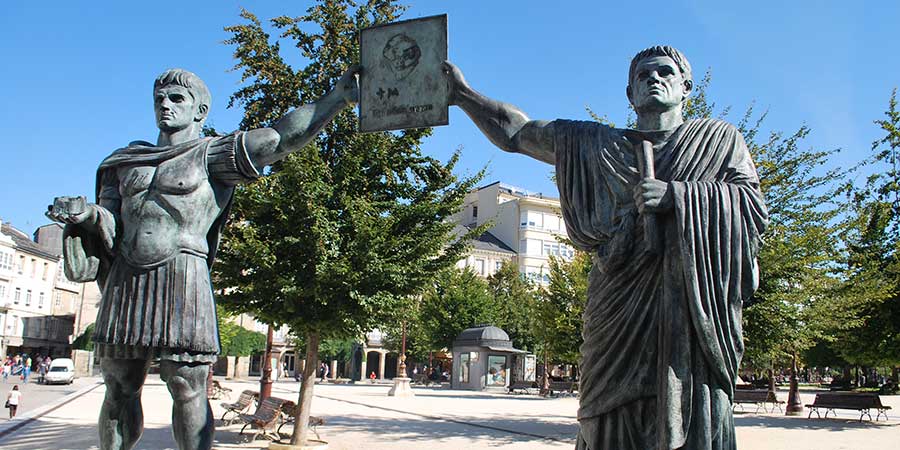Lugo is a remarkable city on the Camino Primitivo, offering history, culture, and a deep connection to its Roman past. Founded by the Romans in 15BC, the settlement was originally called Lucus Augusti and became a central city in the province of Gallaecia. This area stretched across what is now Galicia and northern Portugal and was rich in gold and other valuable resources. Roman influence remains strong here, seen in everything from architecture to festivals.
Table of contents
Roman Lugo
As one of the main centres in Gallaecia, it played a vital role in the Roman Empire’s trade and military presence. Gold mines in the region helped sustain Rome’s economy, and the city thrived as a result. Administrators, merchants, and skilled workers once filled its streets. Today, visitors can still see traces of Roman planning and design throughout its historic centre and preserved sites.

Lugo Roman Walls
The most famous monument in the city is its Roman wall—fully intact and encircling the old town completely. Built in the 3rd century to defend against invasions, this 2km structure is up to 12 metres tall in places. It features 85 towers and ten gateways. In 2000, the wall was recognised by UNESCO as a World Heritage Site, honouring its cultural and historical value. It’s the only Roman wall of its kind to survive in full.
Structure and Access
Of the ten gates, five were added in the 1800s to allow better access as the town grew. Among the original ones, the most famous is Porta Miñá, or Porta do Carme, which opens toward the River Miño. This ancient gate is now a popular exit for pilgrims continuing their route to Santiago de Compostela. The walls not only protect the past but also welcome present-day travellers.
Walking the Roman Walls
One of the best ways to discover the city is by walking the full loop along the top of the Roman wall. The path provides panoramic views of rooftops, historic buildings, and hidden courtyards. It’s peaceful and informative. An Interpretation Centre nearby helps explain the wall’s origins, construction, and significance in the Roman world. Other Roman remains, like mosaics and foundations, are scattered throughout the town.

Discover the Old Town
Beyond the walls, the old town offers a blend of Roman heritage and mediaeval charm. The Cathedral of Santa María and the City Hall are standout landmarks. Several small museums showcase artefacts from Roman times, while the churches and narrow lanes create an atmosphere steeped in tradition. Cobbled streets, welcoming plazas, and busy cafés give visitors a true taste of life here.
Roman Traditions Live On
Every June, the city celebrates its Roman identity with the Arde Lucus festival, a joyful tribute to ancient times. This event began after the UNESCO recognition and has become one of the town’s most exciting celebrations. Locals dress as Roman citizens or Celtic warriors, transforming the streets into a living museum. Parades, workshops, and re-enactments bring history to life for all ages.
Arde Lucus Festival
During the festival, you’ll find a Roman circus, markets, mock battles, and musical performances throughout the historic centre. Families enjoy dressing up, and visitors are welcome to join. Ancient ceremonies, such as Celtic-style weddings, are recreated with care. The celebration blends educational activities with entertainment, connecting the community to its roots in a lively and creative way.
San Froilán Festival
While Arde Lucus celebrates the Roman era, the most traditional event is San Froilán, held in early October. Dedicated to the city’s patron saint, it dates back to 1754. Originally an agricultural fair, it has become a beloved cultural festival. Music, dance, and food take centre stage, and the event draws thousands of people from around the region each year.

Taste Galician Tradition
One of the festival’s highlights is Polbo á Feira, the famous Galician octopus dish. Traditionally served on wooden plates, it’s seasoned with paprika, olive oil, and sea salt. Locals and visitors gather in Rosalía de Castro park to enjoy this simple but delicious meal. Though humble, this dish reflects a long culinary tradition likely rooted in ancient times.
A Pilgrim’s Highlight
For pilgrims on the Camino Primitivo, this historic town is a key stop filled with rich stories and welcoming atmosphere. Whether you’re walking the wall, tasting traditional dishes, or joining in a celebration, your experience will be unforgettable. Its Roman heart still beats strongly, offering a beautiful pause on your journey westward.
If you’re interested in experiencing some of the Camino’s wonderful festivities, make sure to check our Camino Festivals Calendar. If you have any questions or if you would like some help planning your Camino, please don’t hesitate to contact us.